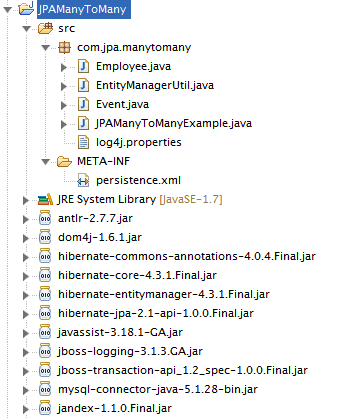Hibernate JPA Many To Many Relation Mapping Example

Hibernate JPA Many To Many Relation Mapping Example explains about how to implement a Many to Many relationship by using Hibernate JPA
Java Persistence API (JPA) is a standard interface which wraps different ORM tools such as Hibernate, EclipseLink, OpenJPA etc. ie; you can able to change Hibernate implementation to EclipseLink implementation without changing the code base.
many-to-many entity relationship, each record of an entity have multiple records in other associated entity and vice versa
On this standalone Many To Many Mapping Example, we are using Java Persistence (JPA) With MySQL Database. If you want to configure Hibernate JPA With other Databases, you can check below table
Let us see how to implement JPA Many-to-Many relationship using Hibernate
Required Libraries
You need to download
Following jar must be in classpath
- antlr-2.7.7.jar
- dom4j-1.6.1.jar
- hibernate-commons-annotations-4.0.4.Final.jar
- hibernate-core-4.3.1.Final.jar
- hibernate-entitymanager-4.3.1.Final.jar
- hibernate-jpa-2.1-api-1.0.0.Final.jar
- jandex-1.1.0.Final.jar
- dom4j-1.6.1.jar
- jboss-logging-3.1.3.GA.jar
- jboss-transaction-api_1.2_spec-1.0.0.Final.jar
- mysql-connector-java-5.1.28-bin.jar
Table structure
create table `employee` ( `EMPLOYEEID` double , `EMPLOYEENAME` varchar (765) ); create table `employee_event` ( `EMPLOYEEID` double , `EVENTID` double ); create table `event` ( `EVENTID` double , `EVENTNAME` varchar (765) );
Create Employee & Event model classes as per the above table structure
Employee.java
import java.util.HashSet;
import java.util.Set;
import javax.persistence.CascadeType;
import javax.persistence.Column;
import javax.persistence.Entity;
import javax.persistence.GeneratedValue;
import javax.persistence.Id;
import javax.persistence.JoinColumn;
import javax.persistence.JoinTable;
import javax.persistence.ManyToMany;
@Entity
public class Employee implements java.io.Serializable {
private static final long serialVersionUID = 1L;
@Id
@GeneratedValue
@Column(name = "EMPLOYEEID")
private long employeeId;
@Column(name = "EMPLOYEENAME")
private String employeeName;
@ManyToMany(cascade = { CascadeType.ALL })
@JoinTable(name = "EMPLOYEE_EVENT", joinColumns = { @JoinColumn(name = "EMPLOYEEID") },
inverseJoinColumns = { @JoinColumn(name = "EVENTID") })
private Set<Event> events = new HashSet<Event>();
public Employee() {
super();
}
public Employee(String employeeName) {
super();
this.employeeName = employeeName;
}
public long getEmployeeId() {
return employeeId;
}
public void setEmployeeId(long employeeId) {
this.employeeId = employeeId;
}
public String getEmployeeName() {
return employeeName;
}
public void setEmployeeName(String employeeName) {
this.employeeName = employeeName;
}
public Set<Event> getEvents() {
return events;
}
public void setEvents(Set<Event> events) {
this.events = events;
}
}
Event.java
import java.util.HashSet;
import java.util.Set;
import javax.persistence.Column;
import javax.persistence.Entity;
import javax.persistence.GeneratedValue;
import javax.persistence.Id;
import javax.persistence.ManyToMany;
@Entity
public class Event implements java.io.Serializable {
private static final long serialVersionUID = 1L;
@Id
@GeneratedValue
@Column(name = "EVENTID")
private long eventID;
@Column(name = "EVENTNAME")
private String eventName;
@ManyToMany(mappedBy="events")
private Set<Employee> employees = new HashSet<Employee>();
public Event() {
super();
}
public Event(String eventName) {
this.eventName = eventName;
}
public long getEventID() {
return eventID;
}
public void setEventID(long eventID) {
this.eventID = eventID;
}
public String getEventName() {
return eventName;
}
public void setEventName(String eventName) {
this.eventName = eventName;
}
public Set<Employee> getEmployees() {
return employees;
}
public void setEmployees(Set<Employee> employees) {
this.employees = employees;
}
}
@ManyToMany(cascade = { CascadeType.ALL }) annotation is used for linking each record of Employee table with Event table and vice versa
@JoinTable(name = "EMPLOYEE_EVENT", joinColumns = { @JoinColumn(name = "EMPLOYEEID") }, inverseJoinColumns = { @JoinColumn(name = "EVENTID") }) is used to define the join table, here it is "EMPLOYEE_EVENT", which is connecting 2 columns ie; EMPLOYEEID belongs to employee table & EVENTID belongs to event table
@Entity declares the class as an entity (i.e. a persistent POJO class)
@Table is set at the class level; it allows you to define the table, catalog, and schema names for your entity mapping. If no @Table is defined the default values are used: the unqualified class name of the entity.
@Id declares the identifier property of this entity.
@GeneratedValue annotation is used to specify the primary key generation strategy to use. If the strategy is not specified by default AUTO will be used.
@Column annotation is used to specify the details of the column to which a field or property will be mapped. If the @Column annotation is not specified by default the property name will be used as the column name.
EntityManagerUtil.java
import javax.persistence.EntityManager;
import javax.persistence.EntityManagerFactory;
import javax.persistence.Persistence;
public class EntityManagerUtil {
private static final EntityManagerFactory entityManagerFactory;
static {
try {
entityManagerFactory = Persistence.createEntityManagerFactory("test");
} catch (Throwable ex) {
System.err.println("Initial SessionFactory creation failed." + ex);
throw new ExceptionInInitializerError(ex);
}
}
public static EntityManager getEntityManager() {
return entityManagerFactory.createEntityManager();
}
}
persistence.xml
persistence.xml file must be under src/META-INF (Please check the screenshot(project structure)
<persistence xmlns:xsi="http://www.w3.org/2001/XMLSchema-instance" xsi:schemaLocation="http://java.sun.com/xml/ns/persistence http://java.sun.com/xml/ns/persistence/persistence_2_0.xsd" version="2.0" xmlns="http://java.sun.com/xml/ns/persistence"> <persistence-unit name="test" transaction-type="RESOURCE_LOCAL"> <properties> <property name="javax.persistence.jdbc.driver" value="com.mysql.jdbc.Driver" /> <property name="javax.persistence.jdbc.url" value="jdbc:mysql://localhost:3306/test" /> <property name="javax.persistence.jdbc.user" value="root" /> <property name="javax.persistence.jdbc.password" value="root" /> <property name="hibernate.hbm2ddl.auto" value="create-drop" /> <property name="hibernate.dialect" value="org.hibernate.dialect.MySQLDialect" /> </properties> </persistence-unit> </persistence>
Project Structure
Now project structure looks like following

Just execute below class and see the output
JPAManyToManyExample.java
import javax.persistence.EntityManager;
public class JPAManyToManyExample {
public static void main(String[] args) {
EntityManager entityManager = EntityManagerUtil.getEntityManager();
try {
entityManager.getTransaction().begin();
Event event1 = new Event("Quaterly Sales meeting");
Event event2 = new Event("Weekly Status meeting");
Employee employee1 = new Employee("Rockey");
Employee employee2 = new Employee("Jose");
employee1.getEvents().add(event1);
employee1.getEvents().add(event2);
employee2.getEvents().add(event1);
employee2.getEvents().add(event2);
entityManager.persist(employee1);
entityManager.persist(employee2);
entityManager.getTransaction().commit();
} catch (Exception e) {
entityManager.getTransaction().rollback();
}finally {
entityManager.close();
}
}
}
Output
| EMPLOYEEID | EMPLOYEENAME |
| 1 | Rockey |
| 2 | Jose |
| EMPLOYEEID | EVENTID |
| 1 | 1 |
| 2 | 1 |
| 1 | 2 |
| 2 | 2 |
| EVENTID | EVENTNAME |
| 1 | Weekly Status meeting |
| 2 | Quaterly Sales meeting |